HD560S
back to Sennheiser
back to measurements
home
published: Sep-24-2020, updated: May-03-2024
NO SMOOTHING is applied to the shown plots. Most measurement sites have some smoothing applied which ‘irons flat’ sharp peaks and ‘wiggles’. I do not use smoothing because some info about sound quality is lost when plots are smoothed.
Aside from a small correction of the microphone itself also some correction in the lowest frequencies is applied to the plots to compensate for the perceived loss of bass when using headphones. This is described HERE in more detail.
A ‘horizontal‘ frequency response curve on the shown frequency response plots on this website thus indicates a perceived ‘flat’ tonal signature.
ALL measurements are made with a good SEAL on a flatbed measurement rig.
The shape of your head, bone structure, pad size, pad ‘softness, (compliance), hair or no hair and or wearing glasses may (drastically) change the frequency response of some headphones, so… your personal experience may differ substantially from these plots.
Frequency response (tonal balance) is the most sound-determining aspect of headphones. A horizontal line shows audible neutral response in the plots on this website. Deviations in different severities at different frequency bands have an effect on the sound character.
The bigger the deviation the stronger the effect.
Below an aid to help determining the sound character of headphones with relation to the frequency response.

Sennheiser HD 560S (>2022)
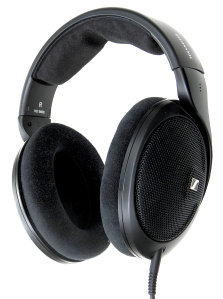
The Sennheiser HD 560S is an open over-ear headphone. The S does not stand for ‘Schwarz’ (Black) nor ‘Symmetrisch’ (balanced) b.t.w. but is indicating a next generation driver. It costs (MRSP) € 199.- at the Sennheiser store. The MSRP dropped to € 149,- in 2022. The HD560S is designed in Germany and is assembled in China.
The HD560S also has no relation, nor is it referencing to, the HD560 Ovation.
It has the looks and mechanics of the current HD5xx range but the driver is improved. It has a different voice coil and different material membrane and is better damped and is built on the same ‘frame’ so looks the same as other HD 5xx drivers but… isn’t.
It is closer to the HD6xx range in some respects than to the HD5xx range. Where the HD6xx series does not have angled drivers or pads the HD560S has its driver angled by about 9°. Below the driver from the front and from the back.
The clamping force is on the high side but not is clamping very hard. The headband padding is soft and looks a bit like that of the HD660S but is not the same construction (not interchangeable).
The velour pads are exchangeable and all black. The same pads are used on the HD559.
Those that have their ear touch the driver and are annoyed by it in the HD6xx series may be pleased to hear there is more depth in the HD560S. The HD6xx series has about 21mm depth in the front and rear side where the HD560S has 21mm in the front and 24mm in the back. When one has very big ears the triangle (for the cup swivel parts) determines the depth. Still… the depth is 24mm and thus more than 21. Add to that the HD6xx series pads is quite soft and more compliant (softer, more squishy) than the HD560S pads makes the difference in depth slightly better as well. I assume the pads will soften up over time.
One does NOT have to worry about seal being essential for excellent bass extension.
The cups can swivel far enough sideways but the vertical tilt is a bit limited. The headband can be extended over a good range so it is possible to get a good fit with larger heads as well.
This is a lightweight headphone that feels a bit cheaper than the HD6xx range.
Note: From Jan 2023 the HD560S ships with a 1.8m cable terminated in a threaded 3.5mm plug with a 6.3mm screw-on adapter. This review is about the newer version as the earlier version is no longer sold.
Originally the HD560S had a 3m long cable terminated in a 6.3mm plug. This is the easiest way to find out if the HD560S is the newer or old version.
The headphone is connected via a 1.8m single-sided cable. On the headphone side it has a locking 2.5mm TRRS connector. On the amplifier side it has a threaded and gold-plated 3.5mm TRS jack plug on the other end. A 6.3mm screw-on adapter is fitted.
The cable alas is a bit microphonic. Not annoying when music is playing though.
Internally the cable is 4-wire construction litz wire and the return signals are combined in the 3.5mm TRS plug.
Note: the cable pinning for the TRRS 2.5mm connector used in Sennheiser headphones is not similar to that of 2,5mm TRRS balanced outputs of amps.
Sennheiser: Tip = L+, Ring1 = R+, Ring2 = L-, sleeve = R-
While pinning for headphone outs from balanced amps (2.5mm TRRS) is:
Tip = R-, Ring1 = R+, Ring2 = L+, sleeve = L-
This means one cannot use 2.5mm TRRS to 2.5mm TRRS cables but has to use a cable with a specific (locking) Sennheiser 2.5mm TRRS connector on it.
There are after-market cables for Sennheiser headphones so one can use the HD560S balanced (in either 2.5mm TRRS, 4.4mm TRRRS Pentaconn and XLR-4-pin)
With a sensitivity of around 108dB/V (specified as 110dB/V by the manufacturer) the HD560S can be used directly from a phone and reach high enough levels for normal music listening. To reach impressive levels it needs a bit more voltage than a phone, tablet or USB dongle. It plays about 3dB louder than the HD650 at the same volume setting. It can play decently loud from a phone and is a very easy load (little current drawn)
Note: I have no affiliation with Sennheiser or other headphone manufacturers. I have not been paid to review this headphone nor have I spent much money on it.
This headphone is the same one as the HD400 Pro. This one has a different logo (smaller and all black) and has 2 cables (3m coiled cable + straight 1.8m cable). This increases the price though. Half 2022 the HD400 Pro was € 225,- (Thomann).
New revision
From 2022 the HD560S comes with a 1.8m cable that has a threaded 3.5mm TRS jack + 6.3mm screw-on 6.3mm adapter instead of a 3m long cable with 6.3mm with a separate short 3.5mm conversion cable. Production costs seem to be lower but the price is increased despite of this.
Aside from the cable the material for the headband padding has changed. In the original version the cloth covering the foam on the headband used to be the same velour cloth as used in the pads.
The new model uses a different material. (upper = new, lower original)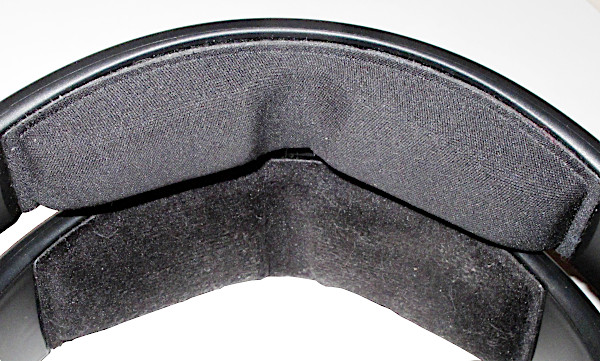
specifications:
Type: Over ear, open
Usage: Home, studio, transportable.
Driver type: dynamic
Pads: replaceable, velours
Collapsible: No
Headphone cup connector: Sennheiser locking 2.5mm TRRS jack
Cable entry: single sided, left cup.
Cable: 1.8m terminated in a threaded 3.5mm gold plated connector with 6.3mm screw-on adapter
Driver size: 38mm (36mm membrane), angled 9°
Inner Pad dimensions: depth font = 21mm, rear = 24mm, Width = 42mm, height = 71mm, oval shaped
Max. power rating: 0.3W
Max. voltage: 6Vrms (17Vpp)
Max. current: 50mA
Max. S.P.L.: 123dB
Impedance: 121 Ω (measured)
Efficiency: 99 dB @ 1mW
Sensitivity: 108dB @ 1V (the data sheet mentions 110dB/V)
Weight: 240 g. (excl. cable)
Clamping force: 3.5-4N (medium-high)
Accessories: 6.3mm to 3.5mm TRS 15cm adapter cable, quick guide.
Subjective sound description:
The HD560S has a neutral sound signature with good bass extension. No deep rumbles at ‘Harman target’ level which may well be a good thing. Bass extension is equal to HD58X and is on the proper level and sounds extended, very natural, not overblown and above all not lacking bass either.
No bloated nor ‘fat’ or muddy bass. Bass is better in level than the usual hD5xx series which often is a bit too ‘warm’. Excellent integration from bass to the mids.
Bass on the newer model is the same as the earlier model. That said… some people perceive less bright headphones as ‘bassier’ probably because it is a bit less bright.
Mids are as expected from Sennheiser. Neutral overall, but (a little too) ‘forward’ because of a slightly elevated ‘clarity/presence’. The mids are dynamic and very open and clean. The HD560S is more ‘forward/clear’ as the HD58X which comparatively sounds a bit more ‘warm’ and somewhat subdued in the treble.
The older version is a bit brighter sounding.
The treble is different than the HD6xx series and more elevated. The angle of the driver also has something to do with this. Upper mids/lower treble is elevated at around 5kHz. This is not high enough to cause sibilance. This can be ‘fixed’ though with some EQ or a filter which makes the treble smoother.
The stereo imaging, which is known to be a bit narrow in the HD6xx series, is substantially wider but not reaching HD800S territory. The HD560S is more dynamic/lively than the HD6xx and HD5xx series. Because of the wide stereo image this headphone is quite suited for gaming as well (but is an open headphone without a microphone).
Measurements:
Below the frequency response of the HD 560S (left, right) 
The channel matching is good. Sennheiser is usually good with consistency in their products and quality control.
Bass is well extended and rolls off very gently below 25Hz. From 25Hz to 2kHz the response is excellent and within +/- 3dB. The small ‘dip’ around 2.5kHz will not be perceived as such but in reality is higher than shown because of the angled driver and response of the ear-canal. The 5kHz area is perceived as above neutral but is beneficial for gamers. So while the plot shows a flat response that area is higher than the plot shows.
The treble is on the right level and well extended.
comparisons
Below the HD560S versus 16 other models.
Note: The plots are smoothed (to get a better feel of differences in tonality). The frequency response is shown between 20Hz and 20kHz.
 The HD560S is quite neutral and well extended and performs well compared to other Sennheiser models as well as some other open headphones from other brands.
The HD560S is quite neutral and well extended and performs well compared to other Sennheiser models as well as some other open headphones from other brands.
phase response
Below the phase response of the HD560S (left, right) Gentle sloping phase changes are not audible. The phase response is excellent. No big variations and L and R drivers are very similar. Only some minor phase differences around 4kHz but or not problematic.
Gentle sloping phase changes are not audible. The phase response is excellent. No big variations and L and R drivers are very similar. Only some minor phase differences around 4kHz but or not problematic.
Very little pad-bounce around 70Hz. There is a small resonance around 700Hz.
output resistance / damping-factor
As this is a dynamic headphone the frequency response can be amplifier output resistance dependent when certain higher output resistance amplifiers are used.
Instead of showing impedance plots, which are hard to ‘read’ when it comes to assessing the tonal balance change in the real world, the HD560S is measured via 4 different output resistors (0.2Ω, 10Ω, 32Ω and 120Ω). On a higher output resistance amplifier the output level will be lower of course due to voltage division. To compensate for this the amplifier is cranked up to the same level (5.5dB at 1kHz in this case). This way the plots are overlaid and it is easier to see how the tonal balance changes.
The tonal balance changes very little when the HD560S is connected to amplifiers with an output resistance below 50Ω. With output resistances above 100Ω the tonal balance is changed audibly.
Some tube amplifiers, integrated amps and (AV)receivers can have output resistances up to 400Ω.
The HD560S should be driven from 0.1 to 50Ω output resistance amplifiers unless you want more ‘warmth’.
Seal can be an issue with closed-back headphones but is usually less of a problem for open headphones. Breaking the seal (improper fit on the head) usually means a loss of (sub)bass.
Perfect seal, seal broken with a thin arm glasses not resting against the skin and seal broken with thick armed glasses not resting against the skin.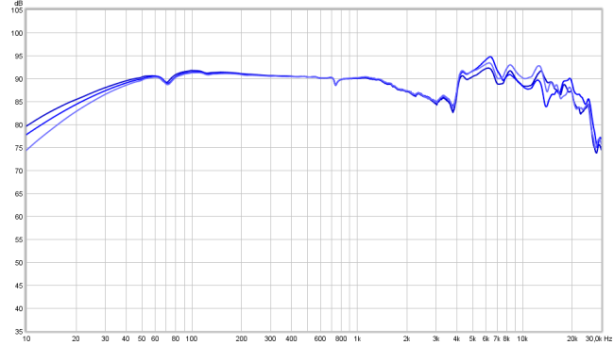 The HD560S is practically insensitive to a seal breach. Even lifting the headphone a bit does not change the bass response much.
The HD560S is practically insensitive to a seal breach. Even lifting the headphone a bit does not change the bass response much.
pad compression
When pads are compressed the ear-driver distance changes which can have an influence on tonal balance as well as the sound getting somewhat louder.
As this happens over many years as the foam inside the pads softens/decays the slightly louder aspect won’t be possible to notice. The tonal balance changes will.
It should be noted that compressing the pads is not exactly the same as foam decaying
Also note that when this happens the pinnae (outer ear) will also be bent and reacts differently and can become unpleasant (hurt even).
Below the change in tonal balance when the pads are not compressed and compressed by 3mm, and 6mm. The plots are overlaid to better show tonal changes.
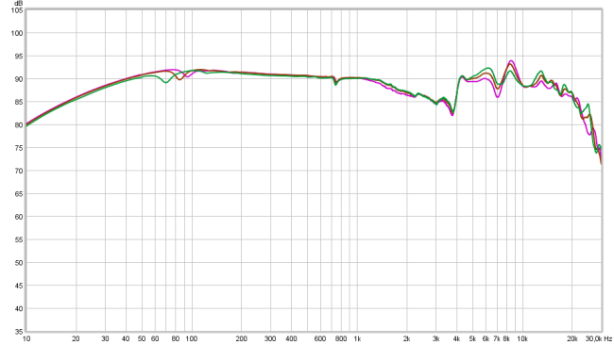 Aging of the pads will not change the tonal balance much over time.
Aging of the pads will not change the tonal balance much over time.
linearity
Sometimes I measure the linearity of the headphones when measurements suggest something is wrong. Basically the frequency response is measured at 70, 80, 90 and 100dB SPL. The traces are overlaid (on the 90dB trace) to see if the tonal balance changes. When the low-bass response is worsened at higher SPL this points to damping/excursion problems.
When the low-bass response is worsened at higher SPL this points to damping/excursion problems.
Here there is as good as no compression visible up to 90dB SPL. Even at 100dB there is only a mild compression visible (note the 2dB/div scale).
Below the distortion measurements of the HD560S (left channel).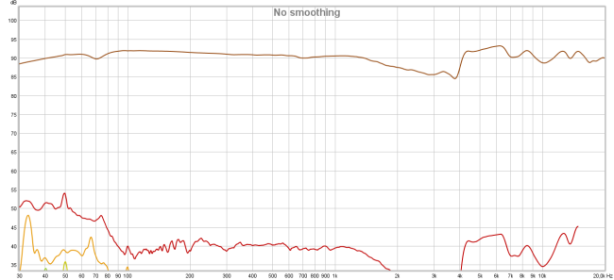
The plot above shows the level differences between the signal (upper trace around 90dB SPL) and the harmonics. Most people prefer to see percentages instead of level differences so below the exact same plot except ‘normalized’ to the actual signal and level differences given in percentages.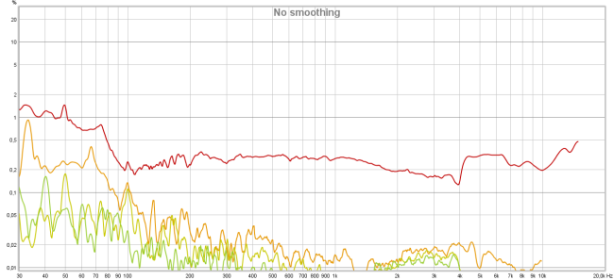
Distortion levels in the lowest frequencies are as expected from smaller diameter drivers. From 40Hz up the distortion levels are already below 1%. Above 100Hz where distortion starts to matter the distortion numbers are impressively low.
The actual 2nd harmonic distortion above 100Hz may well be lower than 0.2% . A shortcoming of my measurement rig.
Distortion level of the 3rd order harmonics remain below 0.1% > 100Hz. All in all good performance in the bass to very good performance from the lower mids to the upper treble range.
Below the distortion of the HD560 with 5dB of lowest bass boost at 95dB SPL. It shows even at high SPL bass doesn’t reach problematic distortion levels.
The left channel showed similar performance so is not shown.
Below the CSD (waterfall) plot of the HD560S . (left and right are overlaid)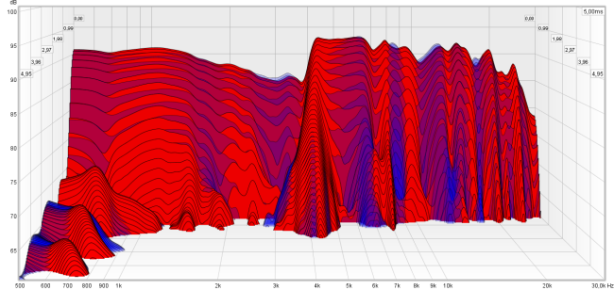
This looks really nice. What can be seen though is a small and short lived resonance at around 700Hz and one around 4kHz which I don’t think is audible because it is short and in the frequency range where the ear itself also has ringing by itself.
A different plot is the spectrum plot. This basically is a CSD (Waterfall) plot but viewed from above where the level differences are colour coded instead of being in the vertical axis. Also the frequency range of the spectrum plot is wider (from 100Hz instead of 500Hz). The time span is also bigger in the spectrum plots and expired time is shown from below to top where in the CSD the time is shown from rear to front.
Below the spectrum plot of the HD560S (left channel)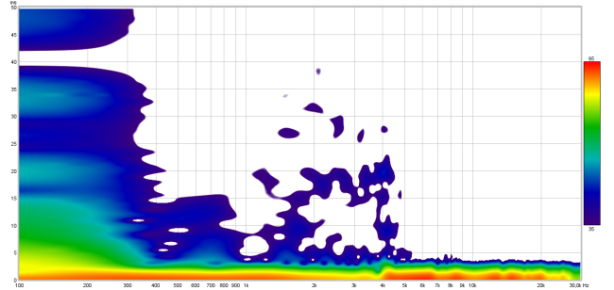
The plot shows a fast decay in the lows and no obvious errors in the time domain.
square-wave and impulse response
Below some measurements of a 40Hz and 440Hz square-wave and a 100µs impulse on the HD 560S.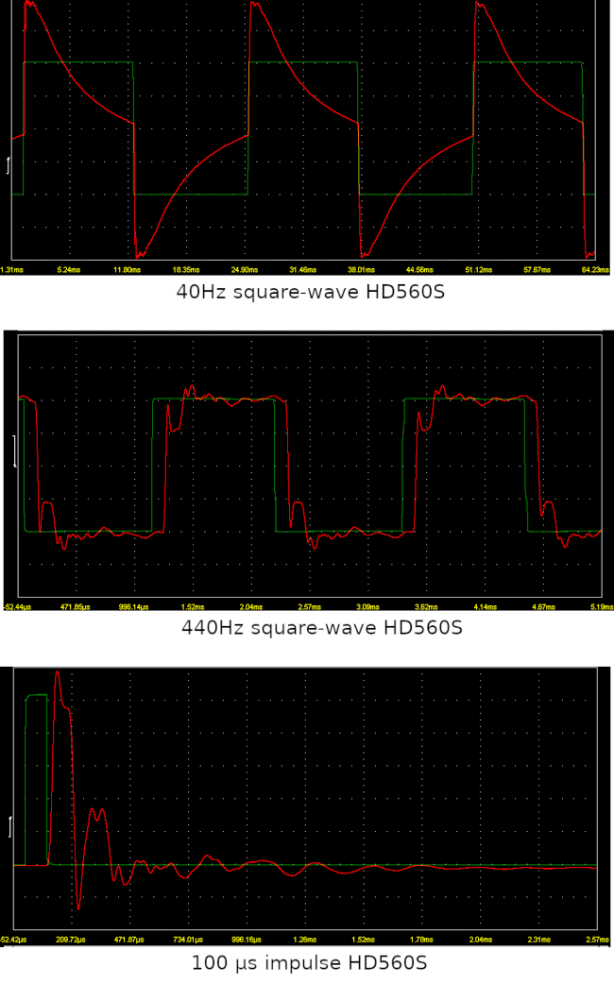 The 40Hz square-wave response shows decent bass extension indicated by gradual, not very steep slope of the horizontal part of the applied signal.
The 40Hz square-wave response shows decent bass extension indicated by gradual, not very steep slope of the horizontal part of the applied signal.
The 440Hz square-wave response shows good tonality (follows the applied signal closely) with a very small emphasis on ‘detail’ (the short peak after 0.2ms).
The 100µs impulse almost reaches the desired level, is nice and sharp looking and has some minimal ringing after the pulse is gone. The driver seems well damped.
The time difference between the stimulus and measured signal is caused by the speed of sound and the distance between the driver and microphone.
Passive filter (treble fix)
The small, but audible treble peak at around 5.5kHz can be lowered with some PEQ but this is not always possible or desired.
A rather simple passive inline-filter can be constructed that only addresses the problem area.
Below the effect the filter has on the frequency response of the HD560S. This filter lowers the elevated area between 3kHz and 8kHz (centered around 6kHz) by 4dB.
This filter lowers the elevated area between 3kHz and 8kHz (centered around 6kHz) by 4dB.
For those who don’t want a ready-made filter below the schematic diagram for those that want to D.I.Y. one.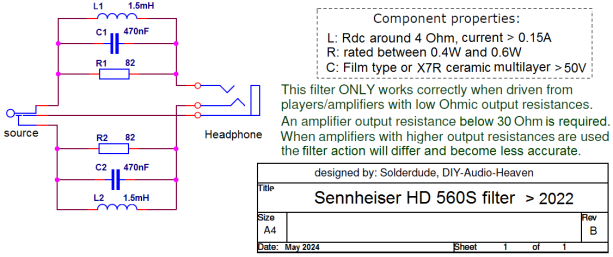
Below the filter sections for left and right driver built into the left HD560S cup.
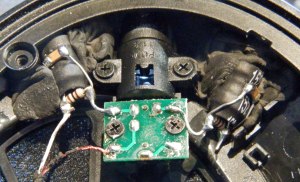
Replacement pads
Around late 2022 it proved nearly impossible to purchase original replacement pads for the HD559/HD560S/HD400Pro. There are a few aftermarket pads which have a different look, comfort and probably also different sound. On Ali-express (Poyatu shop) there are cheap replacement pads available that look like original pads.
Below Poyatu pads on the left and original pads on the right.

 It is obvious they look very similar. Height is the same as well.
It is obvious they look very similar. Height is the same as well.
The space for the ears is not the same though.
The Poyatu pads are 68mm high where the Sennheiser pads are 71mm high.
Width for Poyatu =40mm and Sennheiser = 42mm.
So there is still sufficient room for the ears. The foam in the Poyatu pads is slightly softer than the foam from the early HD560S pads and more similar to that of the newer (>2022) pads.
Below the measurements for the Original HD560S and with the Poyatu pads fitted.
(This is measured on an early HD560S)

The frequency response is not significantly altered using these cheap Ali-Express Poyatu after-market pads.
These appear to be a viable option in case one does not want to change the sound and comfort much and cannot buy the originals (which I would always recommend) or wants cheaper pads.
post 2022 version
From about end 2022 there were some changes to the HD560S.
These are not just cosmetic (headband padding) and the shorter (now 1.8m) cable with a different connector. The sound and measurements also differ slightly and audible. The differences are not very big in the overall sound and comfort though and it still is a HD560S.
The most obvious differences are the cloth used for the headband.
 Top one is the 2022 version, bottom one is the original one. Foam feels the same.
Top one is the 2022 version, bottom one is the original one. Foam feels the same.
The other change is cable length and connector. The original version came with a 3m cable with 6.3mm connector + short extension cable that converts to a 3.5mm connector.
The new cable is 1.8m and has a threaded 3.5mm connector with a screw-on 6.3mm connector which is much more convenient and will surely be cheaper to manufacture.
The changes, however, did not stop there. The foam in the earpads is a bit softer in the newer pads.
Cloth used seems the same. Height and shape seems the same.
To confuse the picture a bit more I measured another >2022 model which appears to be tonally a bit darker than the newer version in the review. This seems to be a production spread issue.
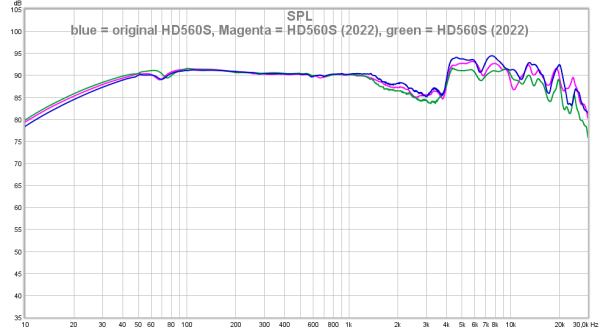 The 2022 version has about 2dB less treble.
The 2022 version has about 2dB less treble.
The most common complaint about the HD560S is that it was too bright (upper mids/lower treble).
The interesting thing is that the newer version has almost the same attenuation as what it achieved with the filter. The > 2022 HD560S thus is a bit less bright sounding. This is a good thing and it seems Sennheiser has taken these comments to heart and improved on it. Sennheiser did not bother to inform the public about this or name this a HD560S-II or something. A silent revision it seems (other than the obvious differences).
Another thing that caught my eye when swapping pads was that in the early version you can see the driver clearly through the dust guard (netting). In the 2022 version this was harder to see.
Below the difference between the 2 dust guard (held against a back-light)
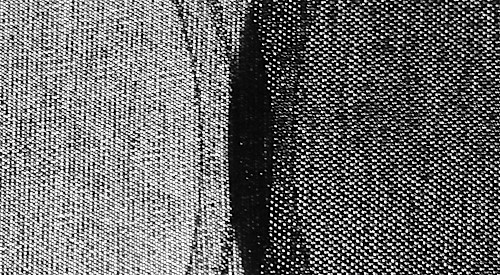
On the left the original dust guard, on the right the >2022 version dust guard. It seems less permeable. One can use different materials in front of a driver to influence treble as shown in this article. Below the effect of the thicker (2022) material. The difference is marginal (about 0.5dB max).
 It appears that this does not do much but adds a little combined with the 2022 pads.
It appears that this does not do much but adds a little combined with the 2022 pads.
Below pictures of the drivers of the old version (left) and 2022 version (production date on the driver is June 2022).
There is a different stamp used. The earlier one had IE00576672 on it the 2022 version just 576672 (so without IE00 before it) and the plastic used on the 2022 version seems a bit more opaque.
 Whether or not this also means a small change in the driver (apart from the stamping) is hard to tell without testing more of them with certainty. The differences found with the pads and dust guard do not seem to be the only reason for the differences in measured response. Also it is not clear whether or not this is just production tolerances, small changes in the material supply chain nor that it was an intentional change to address the often heard comment about the excess brightness.
Whether or not this also means a small change in the driver (apart from the stamping) is hard to tell without testing more of them with certainty. The differences found with the pads and dust guard do not seem to be the only reason for the differences in measured response. Also it is not clear whether or not this is just production tolerances, small changes in the material supply chain nor that it was an intentional change to address the often heard comment about the excess brightness.
Conclusion
The Sennheiser HD560S is an affordable headphone in the HD5xx range. In sound signature/quality it is close to a better extended and even more forward HD600 but with the looks and price of the HD5xx range. The clamping force is a bit on the high side but certainly not too high. The light weight is pleasant and aside from the clamping force you hardly notice you are wearing them.
This headphone can be used directly out of a phone when you don’t feel the need to play very loud. Decently loud is no problem.
An external amp allows you to play impressively loud.
The sound signature is neutral with well extended and nice clean sounding bass. Neutral, lively and ‘open’ mids with an emphasized clarity with some recordings bordering on shouty presence. The treble is a bit less refined due to the emphasis of the upper mids/lower treble (4-6kHz) but can be fixed by EQ or filtering. This lowers the clarity and treble quality ‘calms’ and is smoother but more sparkly then HD600 and much more ‘spacious’ sound.
Those wanting/needing to do some mastering or mixing get a good and affordable tool for this.
For the professional world there is the HD400PRO (which is the same as the HD560S) and the HD490PRO.
For low cost Hi-Fi enjoyment this headphone is an excellent choice in this price segment. With some EQ you end up with spacious and realistic sound that is very detailed.
Despite the still increasing prices of high end headphones there clearly are also quite a few improvements in the lower price segment making the gap between affordable (€150-€200) and high priced headphones smaller. This is one of those headphones.
A good affordable alternative to HD600 with a wider stereo image and less forward mids. The filter lowers the clarity to much better levels and makes this an excellent quality headphone that does not need EQ with it and is playing slightly louder than the HD58X and HD6XX
The cable is a bit microphonic but replaceable. The locking mechanism seems exclusive for the HD5xx range. The 4-contact plug into the headphone suggests a balanced cable (hopefully a shorter one as well) might become available.
in short:
The Sennheiser HD560S is a very good headphone in this price segment. It is not flawless and needs some ‘fixing’ but when looking for an excellent and realistic sound reproduction with a wide stereo image and clarity the HD560S is a headphone that should definitely be on your list to audition.
Not recommended for:
Bass-heads looking for huge bulky lows
Those looking for ‘warm/bassy’ headphones
Those looking for bright splashy headphones (Grado/Beyerdynamic/AudioTechnica treble).
Those looking for V- or U-shaped headphones.
Portable usage (where isolation is needed).
Recommended for:
Home usage and indoor ‘portable’ usage (when isolation is not of importance) and ‘accuracy’ is desired.
Serious listeners that like to listen to high quality recordings but don’t want to spend more than €/$ 200.- (and not afraid to use EQ or filter)
Gamers will like the sound quality and stereo image with sharply defined ‘positioning’. No microphone though and maybe a bit light on the bass for gamers.
Those that like a wider stereo image and dynamic lively sound

Thank you so much man for what you did and shared on your website here I can’t believe this section doesn’t already have like 200 comments or so.
Been re-visiting your website now and then and always pleased to read what you write! The inline filter I got from you is also still working flawlessly.
Thanks for the review, could you make a comparisom with the new 2023 Version?u
The product manager told me the sound has not changed. Only the headband fabric and cable have changed.
First of all, thank you for this nice review!
Regarding the higher than desired energy from some 4.000 hz and above, have you tryied /do you have any measurements of using a thin layer of foam or something like that in front of the drivers?
I love what this headphone is capable of at this price point, but I love a little less that surplus of energy.. as of now I’m equalizing it but I would like to implement a passive one.
Materials in front of the driver usually only affect frequencies above 6kHz or so.
Have not found any materials that for instance lower 4-8kHz but leave upper extension as it is.
Passive implementation is best done using filter that only lowers that what needs lowering.
You noted increased “warmth” when using the HD 560s with higher output resistance amplifiers. Was there also an increase in bass distortion as observed with the 58x?
The amplitude (swing of the membrane) increases on a higher output resistance, assuming the loudness difference due to voltage division is compensated for, then distortion in the lows also increases slightly. The same would happen if you EQ the bass upwards though.
How do I order a treble filter for my Sennheiser hd560s
you can contact me by filling in the contact form:
First of all, your work here is astounding, thanks for sharing this. Out of curiosity, between the HD560S, the HD600 and the HD660S which one do you like more/think it’s better in most aspects? I’m looking to get one of these but I’m not sure. I lean towards the hd560s since I have heard that they are quite neutral and with better bass extension than the HD600, I understand that the hd660s are not very neutral.
HD600 is leanest in the bass and has forward mids and clarity without sharpness.
HD660S can be used without much EQ and is a bit less forward/clear sounding.
HD560S has wider stereo image, well extended but a bit too bright (brighter/sharper than HD600).
A little EQ(or merely filtering for HD560S) is very good.
How does the HD560s stack up against the SHP9600 by Phillips?
IMHO very favorably but not everyone might agree.
The Philips sounds overly warm/congested and is lacking clarity compared to HD560S.
Not in the same ballpark.
The older SHP9500 is actually closer in signature but the HD560S certainly is better than the SHP9500.
Hi
Thanks for your work.
Do you know where i can find balanced (2,5/4,4) cable to optimize(?) the listenning experience?
thx
best chance would be at e-bay. Balanced is really only needed for portable gear or when you have an amp that only has balanced out. Otherwise there are no advantages.
Bro! How many cores are inside the cable?
I want to make a 4.4mm balance cable from the original cable, is it possible?
Given the 2.5mm TRRS connector I would expect 4 wires. Didn’t cut the cable to check though.
Any budget dac amp combo recommendations for the HD 560s? Just for music, lectures and maybe some gaming (with a laptop). Thanks in advance.
Most simple dongles should already be enough to drive the HD560S. In order to get impressively loud levels you may need a bit more power.
Any DAC/amp that can handle the music you want to play and can reach 20mW or more in 300 ohm will be more than enough.
Thanks!
This looks like a good rival to the new DT900 pro x. Can you describe the difference between the two?
See:

The DT900X has different comfort, is a bit ‘sharper’ sounding and has more ‘warmth/fullness’.
Is the bass on par with dt990 250ohm? Thinking of upgrading. I like kick drum bass a lot.
What is the frequency curve like vs the dt990 250 ohm and k371?
Bass is very different than DT990. The DT990 has much more bass and has warmth to it. The HD560S has less bass, well.. actually no emphasis as DT990 has, but extends deeper. If you like the bass on DT990 and want a different a cleaner/less warm/fat bass then HD560S could be an option.
The DT990 is U-shaped and has elevated bass and treble, the HD560S does not.
The K371 is similar-ish to a HD560S but sounds like it has a subwoofer attached to it. This is VERY seal dependent, breaking the seal slightly results in much less bass. When moving around this can happen.
K371 is closed and bass is seal dependent. HD560S is open and bass is not seal dependent.
Hello.
Why does this come with a TRRS cable if it doesn’t have a mic? Can I use the TRS cables of my old ATH M50x’s? It seems that they fit and work perfectly.
Sorry if my questions are stupid, and thanks in advance for the answer.
Not a stupid question. The reason is the headphone is now ‘balanced ready’ as it were. When you buy a balanced cable (XLR-4, Pentaconn or 2.5mm TRRS) with the HD560S it can be used balanced without having to resort to dual entry (think HD6** series).
So actually a really nifty feature. Especially since it also has some (very small) benefits using it with SE (TRS jack) amps as the ‘return wires’ remain separate all the way to the 6.3/3.5 mm connector.
560s vs 880 (32) vs 702 vs 712 plssssss………..
which one is more even left-right ?………coz I’ve heared things about 560s…….
THX!
Do you mean which one has the best channel matching or which one has the most even tonal balance ?
The HD560S I have heard and measured and the ones I have been measured by others do have good channel matching between L and R but as with all headphones, even very expensive ones, there can be duds. Sennheiser is not worse nor better than AKG and Beyerdynamic in that aspect.
Will the peaking treble decrease when the pads wear out?
Good question.
I added a measurement for pad compression to the article.
When the pads are compressed substantially the frequency range below 1kHz is becoming relatively louder so the brightness is lowered.
It should be noted that before the treble is finally at the ‘correct level’ the pads are compressed a LOT.
In that case the HD560S is already uncomfortable to wear as it would already almost have become an on-ear with the driver touching the pinnae.
Ah, I just noticed you updated your answer.
Thanks for the measurement.
thanks for all your hard work solderdude. your reviews are invaluable.
after almost 2 years of owning my 560s I was thinking of getting pad replacements. it occurred to me perhaps trying using the pads for the hd 569 (whenever Sennheiser start supplying them). do you think the sound signature would change considerably? also, I am just assuming they will fit since the chassis is so similar but I don’t know for sure, do you think they would? any thought is much appreciated
The pads will very likely change the sound. How much is hard to say but it will be a departure from the neutral sound signature it has.
Hi, thanks for this as well as all the rest of your excellent and objective reviews. The modification tips are also very welcome for tinkerers like me. Between the 560s and the 58x, which ones would you say are just generally more pleasant to listen to every day? I do like detail/clarity, but the 560s (my first and so far – only Sennheisers) do tend to be a bit too bright for me on some recordings. If the FR graphs are anything to go by, the 58x seem like a perfect candidate to hit my sweetspot – more or less a 560s with lower/more refined/more forgiving treble. Is that the case or are they outright muddy in comparison? Thanks!
I have a preference for the HD560S (with filter). Someone else may have another preference.
The stock HD58X is a bit too ‘muddy’ for me so modified mine.
Thanks for taking the time to reply! Ah, I was afraid that might be the case. I didn’t want to have to apply mods but I’ll give the filter a go. I tried achieving the same effect with EQ and it does help.
Thanks for the nice review, id like to ask if you can make a comparison to the new Revision Version of 2023 maybe with a comparison of the frequency responce curve.
The product manager told me the sound has not changed. Only the headband fabric and cable have changed.
If I want to use an EQ like peace how would I apply the same fix? Do I just put -3.7 at 4kHz at 1 Q? Thanks
forgot to mention this is for gaming, and you said the 3-6khz would be beneficial for gamers so would it make more sense to do that at 7khz with a higher Q?
7kHz is in the sharpness range. 2-4kHz is used more for location detection.
I don’t use digital EQ but probably a Q somewhere between 0.5 and 1 would be correct. Just move the frequency a bit up and down to see where you perceive it.
Thanks so much! Your site and reviews are super helpful, and I was able to make my headphones sound a lot better thanks to you.
Hi!!! just wondering too! I have this headphone but its a bit brighter sometimes, where did you ended up the EQ? At 7khz or 4khz? and how many DB and Q?
The filter has a center frequency at 7kHz (-5dB) and stops working around 3.5kHz and 11kHz.
Hi Solderdude,
saw your good work here and at ASR! Very helpful.
I’ve got the HD 58X from Drop recently and modified it today with your 3.5mm felt disc suggestion to lower it’s “muddiness” that worried me some.
Now it sounds much clearer and more open, even without EQ, but now the 4kHz “bump” is quite disturbing in some songs. I have to tame it with EQ around -4 to -5db to avoid sibilance which is quite more than I would expect from your measurements.
I’m quite sure I made holes of 3.2-3.5mm in both felt discs which shouldn’t alter the highs so much?
Any ideas?
Am also considering buying some used HD 560s instead because that seems to be a good option, too. If I had read the good reviews about that I wouldn’t have ordered the HD 58X… It seems the 560s might be even better than the 6xxx series?
I prefer a clear sound with good separation but without too much harshness (as in most Beyerdynamics) and am mostly listening to classical and acoustic jazz, but also some good Progressive Rock from the 70s, and also make some recordings of guitar and software instruments, so use headphones for mixing and mastering, too.
Have also bought a Beyerdynamcis DT 900 Pro recently I’m not completely happy with – I’ll write about that in the regarding page.
The 4kHz bump is more pronounced using the felt with hole mod versus the foam covering the hole mod. Also there is some peaking there that, when modded, is less ‘obscured’ so filtering helps.
Personally I prefer the HD560S (with filter) over the foam modded HD58X with filter)
You could consider the OLLO S5X (with felt mod) but this one costs more than HD560S+DT900X.
When mixing the S5X (as is) would be the best choice.
Also for evaluating the final master the S5X would be the best option (with the felt mod).
Low budget alternative HD600, HD560S (with filter)
I have to apologize for taking so long to answer, but I tried some other things in the meantime.
As it got clear, my “holes” I put in the felt (just with a drill) CLOSED again a good fraction, so that they were more like 2mm, and because of that the effect was much too big 😦
Now I tried again with a belt puncher(?) but alas, 4mm was the smallest choice and that produced effect almost as no felt at all.
This method is really VERY VERY sensitive!
Now I tried one last thing: I put the felt with 4mm holes slightly down so that perhaps 1/2mm is outside of the magnet hole (I hope that is understandable; I’m no natural English speaker) and it was quite perfect!
So one really has to reach the smart spot here with some try and error, but now the HD58X sounds quite natural even without EQing and to get it perfect only about +1.5db @100Hz LS, +1dB HS @7000 and perhaps 2 wide peaks -1db@220 and -3db@3950 are sufficient. So not much of gain is lost, which is important for use at my mobile player (an Samsung R0 with Rockbox OS).
I think I’ll try the 560S nevertheless as a 2nd option if i get a good 2nd hand offer.
Thanks a lot for the felt disc mod!
Okay, I’ve finally added the filter on mine – had to order inductors off AliExpress as I couldn’t find any locally.
The effect is as described – the headphones now sound more natural and are not overly sharp. Highly recommended!
A couple of things to look out for IMO:
– space is really right – I was barely able to fit a small film type capacitor. I initially tried to use a 330nf/400v WIMA cap and that was a definite no-go. Also – make sure your solder joints on the PCB are as flush with the board as possible – apart from not having much space for the components, you also don’t have a lot of room behind the PCB once you close them.
– be careful when soldering on the board and plan out how you position the components – Sennheiser seem to be using a really cheap PCB and I ripped one of the traces of while adjusting the components.
– be extra careful when closing the headphones – I opened/closed mine twice – once after adding the filter to verify that it’s working and I like the effect, the second time to hotglue the components – upon closing them the second time, the threading on one of the 3 screws started to not catch the screw properly. I was sure not to overtighten the screw, but it still happened.
Thanks to Solderdude for the diagrams! Happy modding!
Nice review! Thank you for explaining 2-4kHz is the location detection range for positional imaging in games.
I purchased the 560s but my unit elevated the center channel of the soundstage slightly above the left/right channels. The center channel also felt located more forward in my head than the L/R channels, towards my eyes and forehead. The center channel also felt shifted slightly to the right.
The end result was it felt like vocals were coming from the front of my forehead, just above the eyes, and slightly to the right. It felt very weird and off-putting so I returned the unit.
I tried positioning the headphones on my head every way possible but couldn’t fix the issue. It sounded like one of the angled drivers wasn’t seated correctly so it was off angle and throwing the stereo image off. I’ve read multiple review comments of other people experiencing a similar issue. It’s probably just unit variance.
I’ve ordered the TYGR 300r instead. If I don’t like it, I’ll probably try a different 560s unit and hope it was just unit variance causing the imaging issue.
I like that the TYGR has half the clamp force (read that in your review!) Guess I’ll see if I can handle a tamed Beyerdynamic treble cannon with bass bleed into the midrange.
Keep up the great work SolderDude! Thanks for sharing you insights.
Thanks for the pointers. I’ve successfully modded mine with the filter as well.
For the inductors I used Coilcraft RFB1010-152L (max CC resistance 2.4Ohm), a bit on the big side, but they were the closest match I could source. For resistors, hand-picked 200Ohm 0.25W (two in parallel per channel to get 100Ohm 0.5W). And some NOS film capacitors I had on hand, 0.33uF 63V (FACO brand, couldn’t find much info about them), quite nice, but nearly half as big as the inductors.
To fit all this inside the headphone, I opted for mounting each channel in its own cup, right below where the yoke enters the cup, out of the way. Everything was secured to the outer shell of the cup with thick, spongy 3M VHB tape to absorb any stray vibrations.
This approach also allowed me to compare the effect of the filter in one cup before doing the other. To me, the effect is subtle, but it’s there. I think the mod was worth it overall.
Thanks again to Solderdude for the very helpful review and the schematics.
I’m not liking the TYGR 300r. It sounds muddy compared to the 560s. The midrange sounds sucked out and hollow. I’ve noticed treble sibilance on the TYGR with S and T. About the only good thing about them is their low clamping force and comfort. One of the most comfortable headphones I’ve ever worn!
I’m going to order another pair of 560s headphones because they sound much better and I can actually hear footsteps in video games. Unlike with the TYGR 300r where I couldn’t hear any footsteps. I had the same issue with the Beyerdynamic 900 Pro X headphones of not hearing any footsteps in Battlefield 1.
Hi, I was wondering about the comparison with the Brainwavz H5, I also had the AKG 371 and the Superlux 681. I am considering the Sennheiser HD 560S. €200 is the ceiling for me. I don’t like the sharpness and sibilance in the treble, Superlux was a problem (yes, I know there is an adjustment) AKG would be fine, but the build quality is bad. With Brainwavz, I miss the treble detail. now I’m wearing Sennheiser.
Thank you
Great review, been sporting these since launch and they are my go to for gaming.
They pair wonderfully with the xbass function of the zendac and it gives them a warmer sound.
Funny enough i bought the poyato pads before reading this and i can confirm , sound pratically identical to the stock pads.
Hey Solderdude,
I left a comment a while back about your opinion on 560s vs 58x. I ended up getting the 58x as well anyway and I ended up agreeing with you – while I do enjoy the 58x, the filtered 560s is my top pick among everything I own (K550, K371, 560s, 58x). Even then, I do occasionally miss some subbass extension, especially for electronic music. I was wondering if you have any recommendations for something that resembles the 560s (tonality, presence, vocals, soundstage, comfort – especially lightness) but with an even better extension? I’m looking for my “endgame”, so I would spend more than I usually would. I’ve been looking at the Clear MG (OG are nowhere to be found locally), but I’m hearing about QC issues plus your OG review unit had an unacceptable channel imbalance for the price, so I’m a bit hesitant. I’ve also been looking at the 660s2, because for a daily driver I would trade off some of the 560s’s clarity/edgyness in favour of long fatigue-free listening sessions. However, given how similarly the 660s2 and 58x measure, I don’t think that’ll fix my subbass problem. Could the DT 900 PRO X be a decent upgrade over the 560s? Thanks!
Perhaps consider the OLLO S5X as an upgrade that has very good bass extension for an open headphone. Otherwise you would need to look into closed headphones.
this 560s vs k702 plz………thx……..
HD560S is the ‘better’ headphone. Are you looking for frequency response overlay ?
I’m interestedin neutral sound…….so 702 560 hd600 sure-1840 etc etc……and priced in paralel……….for ex. 560-702 or 1840-avantone……..thx……
K702 is not neutral in sound.
HD600 is but lacks low bass.
HD560S is more neutral but has too much clarity.
SRH1840 is neutral and just like HD600 a bit light in the bass and has some sharpness in the treble the HD600 does not.
An option could be the OLLO S5X which is on the warmer/fuller side of neutral and needs the treble reduced a bit (easy to do with some felt)
Hi
Could you post the effect of the filter on frequency response of the newer hd560s?
How would you compare the Focal Clear against the 560s, in terms of soundstage and bass quality and timbre?
@solderdude about the first question, I see that you have one on sale if I got it right. I wanted to know how it measures
see article (added the response of the filtered >2022 HD560S)
Is there a tool that given the electrical circuit can show us the equivalent eq?
Still interested in your opinion in case you missed the question above: How would you compare the Focal Clear against the 560s, in terms of soundstage and bass quality and timbre?
I don’t know about such a tool. I simulate the desired response, build and measure that.
The original Clear sounds ‘better’ to me out of the box.
Have not heard the current Clear which seems to sound less clear than the original Clear.
I bought one to compare against the he1000v2 and seems quite congested at high volumes. I was looking for an alternative.. looking at distortion graphs on ASR it seems that the 560s would better behave at high volumes even in in the midrange. But I am not sure that congestion and distortion are related
I did not listen to the Clear at high SPL so cannot say anything about that. The Clear is ‘hard limited’ for higher SPL because of its low resonance frequency.
The HD560S is a ‘regular’ driver.
About Sennheiser, I would be curious to see a review of yours of the PC 38x and tweaking of the response, I bought one on Amazon..
Someone, within the EU, would have to send one to me to measure.
I have these headphones and I like them a lot. I use them to mix classical and movie music but I would like to know if the Hifiman Edition XS or OLLO Audio S4X models in particular would have a better response, especially for mixing. Could these two models give me a better mixing experience than the HD 560s? Thank you and congratulations for the content.
For mixing I would say the HD560S and OLLO S5X would be most suited.
S4X is less suited (without EQ).
With Edition XS you might end up with mixes that are a little too bright.
Hello, thank you for building this site and giving us a lot of valuable information and insights!
I have used your suggestions to improve my SRH940 and now it sounds better than ever!
I have a question, recently I’m looking for an open-back headphone for mixing, do you think it would be better to use the X2HR or the HD560s, which are designed for professional use, but it seems that the X2HR would be able to do the job as well.
The information I found so far suggests that both headphones sound neutral, and the X2HR’s muddy low frequency issues can be improved by using tape to cover some of the holes in the damping paper. (That’s the method suggested on your website!). Some websites even show that the X2HR has a better soundstage than the HD560s.
In my country the price of X2HR is about 60% of HD560s, do you think HD560s is worth the price difference compared to X2HR?
Thanks again for building this site, it helped me a lot!
X2HR, when modified, works fine for mixing and is a bit more dynamic sounding compared to HD560S.
X2HR can only be found 2nd hand or old stock. Original parts (pads) are not available so aftermarket is all that is available and might sound different.
Sennheiser will support the HD560S for at least quite a few years most likely, certainly when considering the HD400Pro (=HD560S) is going to need to be supported as well for years to come.
The choice thus comes down to comfort, longevity and support over the years.
Thank you for your reply!
You remind me to think about not only the sound, but also the aftermarket support, gives me a great perspective, thanks.
Also, if I need to modify the X2HR, what kind of tape should I use?
the tape does not matter.
Just make very sure the tape covers the exact same amount of hole for both drivers.
Hello, I don’t understand, some people say the ear pads are softer in the new version but you said that they are a little stiffer, so I’m a little confused now
I had both the newer and older model at the same time. Both were used. This might be age difference between the pads or usage. It is just what I noticed. Didn’t measure it (mm compression with a certain weight over a specific range) but just squeezed the pads and that’s how I found what I found with my 2 (used) copies.
Probably also what others do… YMMV ?
Awesome job with the review! Love your remarks and FR measurements. This one is tuned nicely by Sennheiser, was surprised that you didnt mention that the driver seems like regular hd5xx series one but with more dempening for the driver (no holes in the paper on the back of the driver) Also was wandering what capsules do you use in your mesurement rig? Is it Primo EM272 or maybe PUI 5024?
It isn’t a regular driver for the 5 series. It just seems that way because it uses the same chassis (plastic + magnet).
Just like the NDH-30 b.t.w.
original WM61 capsules compensated for usage on a baffle.
Thank you for the reply! Sorry it just seemed like sennheiser abuses that one design of the driver that it always uses in non-premium series, I had experience with 555/598/280/185 drivers and they all sounded pretty much similar with right amount of dempening even tho it had vastly different membrane material, so I just assumed they are very close to each other in terms of raw driver FR with no dempening. If thats the case Sennheiser is very practical with their products. Its just a shame that they wont fix the terrible 5xx yoke amd headband design to something similar to Beyerdynamic dt series or theur own 6xx, or even hdr185 designs.
Oh and thanks for the mic capsule info too. Legit Panasonic elecrets are great, do you use it as a part of ear/head simulated stand or just a flat rig? Sorry to bother with such questions, if you have a dedicated forum tree about your measurement methods I would be happy to check it out if you would be kind to provide a link, thank you again!
Its a production cost thing. Now further reduced by using low wages countries to produce in an attempt not to increase the price.
For decades they are still using the same mechanical design for headbands and driver chassis for the HD6** series.
It worked, just like the BD DT7/8/9 series works for them.
The HD5** is just an attempt to build something cheaper but still of good quality. I have not seen many broken HD5** chassis though. It is just more lightweight and cheaper to produce.
Drivers can be tuned in different ways. They just have to main driver chassis to build on, which makes sense. They can play with membrane materials, shapes, damping schemes etc.
I have been exclusively using the old version HD 560S for more than a year for mixing and mastering, I was coming from an ATH-M70X. I’m very happy with it, but after the positive experience I wanted to ask if there’s a better option for specifically mixing and mastering for less than 500€. I’m quite Sennheiser-biased now, I have an eye on the HD600 and similars, but I’m not sure if they’ll be worth over the HD 560S. I also have an eye on Beyers, but I have no reference.
As an alternative, for mixing and mastering, I could recommend the DT1990 (with filter and the ‘Analytical’ pads) or the OLLO audio S5X.
When it needs to be closed the Austrian Audio Hi-X60.
They are around the € 500.- range.
A cheap alternative could be the DT900ProX.
Hi Frans,
I have owned many IEMs in the past from Sennheiser, to Klipsch, Koss etc. Currently I own Shure SE215, Sennheiser 598 SE and Beyerdynamic DT 900 Pro X. I love listening to music with my dt 900 but in a very narrow band of frequencies, my Senn 598 seems to sound better for certain tracks (maybe upper mid or high frequency). I found my dt 900 to be a bit muddled in the vocal frequency while listening to ‘Voila – Emma Kok’. On my Shure SE215 IEM, it was even worse and quite harsh.
I have been contemplating to pick one of the following options as addition to my current headphone collection for better clarity (vocal and instruments): Sennheiser HD 560s, 600, 650 or Hifiman Edition XS. The Hifiman costs almost twice that of Senn HD 600/650 here. I use Creative Sound Blaster G3 as external DAC/Amp. What would you recommend from the options listed above if you were to pick a headphone for clarity of voice and instruments?
Generally, I am quite satisfied with my dt 900 pro x.
Hello Solderdude and thank you for all the incredible work on all these headphone models!
I’ve been searching for the “ideal” headphones for production, mixing, and mastering for several months. The HD58X was decent, but too muddy for my taste and lacked sufficient bass extension.
With all these news Headphones out these days, I’ve narrowed down the list to a few models. In your opinion, which would be the most interesting in terms best overall performance for professional use? HD 400 Pro is obviously the best value at the moment (I think) but would something « better » and more expensive worth it?
I think this should help other producers / professionals in the audio world as these models are often considered 😁
Senn HD 490 PRO
Senn HD 400 PRO
Audeze MM-100
Beyer 1990 Pro A Pads with filter
Ollo S5X felt mod
Neumann NDH 30
Any other better recommendation ?
I do not own, heard nor measured the NDH30 (would like to but too expensive to try). Same for MM-100.
Between S5X (with felt mod and warmth reduction filter) but have been told by some the later ones don’t need felt mod, not confirmed though, would be a tie on the DT1990-A with filter.
Would come down to availability, price and preference for a brand or comfort. Both brands have good support in parts. Maybe OLLO a bit better on that aspect. Small company, very responsive.
The DT1990 will have less fit/comfort issues on various heads.
Between HD400PRO and HD490PRO and pro usage (HD400PRO is actually consumer headphone) I would bay a bit more for HD490PRO and use it with the mixer pads. That might give the best result.
The producer pads is a bit closer to the HD58X with a bit better bass extension. I find those pads a bit too warm for my taste.
Thanks for this review and for your contributions at ASR. I bought the original 560S a couple of years ago and really enjoy them for most music, especially things like classical and acoustic. They even sound good with electronic/dance music. However, I’ve noticed with music like rock, and especially grunge and alternative, they seem to be just a bit lean for my taste. They are almost too analytical which takes away some of the sense of impact and force in that type of music, as if they’re too airy. I think I prefer a weightier, more meaty sound with that style. I have a couple of questions about that: would a headphone amp help that in any way, or is it simply down to the way these headphones sound (I often listen from a newer M1 Macbook Pro or my iPhone with the dongle and the volume is not an issue)? Would closed back headphones be better for that style of music, and do you have any recommendations for ones that have the detail and clarity of the 560S but also sound weighty and more substantial rather than airy and light? Are there any other open back headphones that would do well with that style of music? Just as an example of what I’m hearing, listening to the Florence + the Machine MTV Unplugged album with the 560S sounds absolutely fantastic, but listening to Pearl Jam leaves me a little underwhelmed and wanting more power (but not really more volume, as they easily get loud enough).
My suggestion would be to use EQ. If that is not possible and want a bit more ‘warmth’ maybe look into the HD490PRO I just reviewed.
Amplifiers can make the sound louder without getting any distortion.
Louder (when clean sounding) also means bass become relatively louder (Equal loudness contours/Fletcher-Munson) so in that p.o.v. amps may increase bass because it can go louder without distortion. In the end it is just louder.
Thanks so much for that suggestion. I experimented a bit with using EQ and it did help a lot. I think I was (wrongly) under the impression that if I prefer a neutral sound then that should be true across all genres of music, but I now realize that’s not the case at all. In fact I do prefer less neutrality when it comes to rock. I’ll continue to experiment to see what sounds best for me, but I appreciate your help in saving me from having to make another purchase!
Yep, for Yazz and Blues(Rock) the tonality, in general, of the HD560S is good.
For Rock, older pop songs and classic rock, also in general, a little bass boost/extra warmth is often desirable.
There is quite a bit of difference in tonality in recordings as there is no real standard for the recording side.
The good old ‘tone control’ should be common in audio gear and quick to adjust.
Sennheiser did such an attempt (HD630VB) but the execution was a bit poor. It was super easy to adjust bass with these though.
Speakers and headphones are just tools in essence. With speakers there is also room acoustics and with headphones there are differences between auditory systems (ear+brain) and its ‘coupling’ and measurement fixtures. In both cases some ‘seasoning’ towards personal enjoyment or correction is often needed.
Having something that measures towards a standard (whatever standard that may be) is a good starting point but may not be desirable in all cases.
Hello Solderdude, you recommended me this headset instead of DT900 Pro X and AKG K702, thank you again.
Currently, the old version HD560S is sold for 143€ on Amazon.de and the new version HD560S is sold for 220€ on Sennheiser’s site. At the same time, HD 600 is sold for 299€ at Thomann. I could buy the old HD560S and get closer to the new version, but do you think the HD 600 is worth the extra $156?
I would get the older version which is much cheaper than new HD600.
Comfort is different, stereo imaging differs.
Is it known whether the HD 400 Pro also underwent the treble reduction revision you say the HD 560s had? I am curious because around mid 2023 I ended up forking out the extra cash to get a 400 Pro after repeated QC issues with the revised 560s (the one with the mismatching headband pad) and wonder which sound I likely am getting. I assume that if both the 400 Pro and 560s underwent a revision at the same time then I would have received a revised version since I got a revised 560s. I saw on a different forum somewhere that the 400 Pro retains the harsh treble of the original 560s, but I do not know how well informed the claim was and I do not have keen enough ears to be able to tell myself.
The Sennheiser PRO department and consumer department are separate entities. The HD400PRO is made with the same components as the HD560S but differ in the supplied cables and paint job on the grille.
It is very likely the HD400PRO has better matching drivers (smaller product tolerance selection) but that’s only what I would do to warrant the price difference and not a fact.
It is also likely the same components are used so headband material and pads. This means eventually (HD560S will have sold more so will be quicker to replenish stock) they will both be similar in performance again but (I presume) with better L-R driver matching on the HD400PRO.
A give away would be the headband cloth and the date stamp on the drivers. When someone loans me a recent HD400PRO I can measure it.
Hi! I got these (1.8m cable version) today and they sound warmer than I was expecting, so I’m thinking maybe I’m doing something wrong? I plugged them into my phone (Redmi 12) and into the back of my PC motherboard (Asus TUF B760), and while they are louder when connected to the PC, the sound profile is the same. From the reviews I’ve read it seems these should be brighter, I even listened to some binaural demos (e.g https://www.youtube.com/watch?v=YTBaqSX2RzA) to get an idea of their sound and the clarity is just not the same, they sound pretty close to my old headset (Sennheiser GSP 301), bass is not as fast as I expected, I can even feel some subbass, they sound bassier than the samples I listened. All this time I’ve been using some NiceHCK Traceless earbuds and they are noticeably brighter, voices sound clearer, so I’m thinking maybe:
– Listening to the samples through the earbuds gave me a wrong impression about the sound profile of the 560s.
– Sound samples used a DAC and maybe that is what makes them sound clearer. But would the sound change so drastically? I’ve never had a DAC so I don’t know.
– I received a faulty unit? they don’t sound bad though, I was just expecting a different profile.
Any insights would be greatly appreciated.
The current version does seem to have a higher product tolerance so not all HD560S may sound exactly the same.
Overall the newer versions (1.8m cable) are a bit less bright and as a result (a bit depending on how one’s brain is wired) this could be perceived as less bright, a bit warmer or bassier.
Of course, listening at louder or softer levels also can alter the impression of a headphone (Fletcher-Munson/loudness contours).
A DAC should not sound different unless the DAC is faulty or has ‘slow’ or ‘no’ filters, then they might sound different.
When a headphone is defective they usually only are on one side.
The chances of both drivers being broken in the same way is extremely small.
The HD560S is not a bassy headphone (less warm/bassy than HD650) but has better bass extension and is a bit more neutral.
Could you write conclusions about new (1.8m cable) version? and, is the new version good at mixing and mastering?
The newer version is a bit more suited for mastering.
When mixing the older version may be more of a suited tool as you can hear some ‘details’ a bit better/more clearly.
Hello, so if i understand correctly the main difference between the old version and the new ”less bright” version are the pads? I have the old bright version, if i buy a pair of new pads can i tame the brightness as per your graph measurements? also if i add a 120ohm impendance adapter on the jack end can i make it warmer ? Thanks
The biggest contributor to the change seems to be the pads but also the cloth in front of the driver is involved and I have been told that the driver has been slightly changed too.
Indeed adding a 120ohm series resistor will make it a little warmer sounding as well but at the expense of 6dB in max volume for any given amplifier/output.
So when it can play much louder than you need it to go this trick will work.
Hello Solderdude.
Greetings from Argentina.
Your analyzes are impressive and I really appreciate it
I don’t understand the purpose of the passive filter in the 2022 version. Could you elaborate?
The early model had a raised response between 4kHz and 8kHz which gave it an audible brightness.
With this part lowered in the >2022 version a , very similar to HD660S/HD58X, smaller and narrower bump still remains which can give the headphone a ‘rough-ish’ sound (sorry no other words to explain this).
The filter lowers that 5kHz peak a little, just like it does for HD58X and HD660S. The difference is small (subtle) but appreciable for someone that hears it and is bothered by it.
Most people, however, won’t hear it let alone be bothered by it.
hey Solderdude
If you could choose the original version or the 2022 version, which would you choose? Which one has better sound?
The sound quality is the same. The newer version just is a bit less bright.
The original was a little too bright.
So.. when you have a choice and you prefer a brighter sound choose the early one (3m cable), when you don’t prefer bright headphones you should buy the current version (1.8m cable).
Some may find the newer ones a bit ‘duller’ compared to the older ones.
The newer version is a bit more ‘neutral’ in a technical sense. I can not predict what (prospective) owners might prefer.
Hi. Has there been any change to the section about pad compression and seal from before? I recall a different graph with blue lines in the pad compression part. If so, is the new pad compression graph more accurate or was it updated to reflect the new pads that come with the 1.8m cable version? Thanks.
Updated… because these days one can only get the >2022 version of the HD560S. It is rather pointless to see what the older version does when it isn’t available any more.
The rest of the measurements is now re-done on the current HD560S which seems the most logical thing to do. Before the review was a mix of early and later HD560S which is confusing.